Until thirty years ago the answer to this question would have been a resounding "No!"
Even though women had officially served in the military since 1901, when the Army Nurse Corps was created, the highest rank they could hold was Colonel. Promotion to "Star Rank," a military term for admirals and generals, was not an option for career minded military women.
Higher career opportunities began to open for civilian women with the advent of the Equal Pay Act in 1963 and the Civil Rights Act of 1964. The top of the career ladder was not visible yet for a woman in uniform.
Finally in 1967 a bill to promote military women to star rank worked its way though the bureaucratic maze and was signed into law. Did the military rush to promote women - of course not. It took another two years for them to get around to that.
Finally in June of 1970 the Army took the first step and promoted the chief of the Army Nurse Corps Colonel Anna May Hayes to Brigadier General - the very first woman to wear a star. Literally minutes later Colonel Elizabeth P. Hoisington, Women's Army Corps Director, received her new star.
Over the next two years three more women were promoted to general, and in the Navy Nurse Corps to admiral - which is the Navy's equivalent to brigadier general. The Marine Corps dragged its heels and didn't get around to making a woman a general until ten years later.
Fortunately that attitude is a thing of the past and today women who choose the military as a career can go all the way to star rank. Each branch of the service has more than one or two women generals or admirals.
Women in the armed forces are wearing one, two, and three stars on their shoulders and are serving at the highest levels of command. They are more than the equivalent of a corporate CEO or company president and have responsibilities for millions of dollars and thousands of people.
Reaching for the stars in the military is not an easy goal to pursue. It requires a college education, attendance at military staff and command schools, advanced studies and many years of service. But it is not a closed door anymore. Now young women who are thinking about a military career can follow their dreams all the way to the stars - and beyond.
Over fifty women in the military wear the stars of an admiral or general and more have been selected to pin them on next year - a small number indeed but a big step since there were none prior to 1970.

The First Women to attain One Star Rank:
Army - Brig. General Elizabeth P.Hoisington - 1970
Navy - Rear Admiral Fran McKee - 1976
Marines - Brig. General Margaret A. Brewer - 1978
Air Force - Brig. General Jeanne M. Holm - 1971
The First Women in Nursing to attain One Star Rank:
Army Nurse Corps - Brig. General Anna May Hays - 1970
Navy Nurse Corps - Rear Admiral Alene B. Duerk - 1972 - the very first admiral.
|
Air Force Nurse Corps - Brig. General E. Ann Hoefly - 1972
| | | | | | | | |


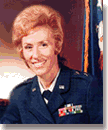
The first military woman to wear two stars - Major General in 1973 - was
General Jeanne M. Holm, the first Director of the WAF - Women in the Air Force.



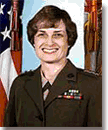
Three stars -
in 1996 Lieutenant General Carol A. Mutter
became the first woman in the Marine Corps to attain 3-star rank.
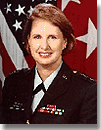
In June of 1997 Lieutenant General Claudia Kennedy
was sworn in as the first U.S. Army 3-star general.
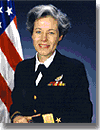
Vice Admiral Patricia Tracey is
the U.S. Navy's 3-star flag officer. |
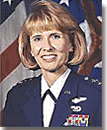
Lt. General Leslie F. Kenne, U.S. Air Force,
was promoted to 3-star rank in 1999. |

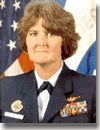
Rear Admiral Vivien S. Crea, was the
first woman promoted to admiral in the U.S. Coast Guard in 2000.
| 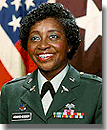
Brigiadier General Clara Adams-Ender was the 18th Chief of the Army Nurse Corps from 1987 to 1991.
She retired in 1993 after having served over thirty years. |
| And what about Admiral Grace Hopper, often referred to as the first woman admiral in the Navy? Grace Hopper retired from the Naval Reserve with the rank of Commander at the end of 1966. She was recalled to active duty in August of 1967 for what was supposed to be 6 months, then her orders were changed to say her services would be needed indefinitely. She was promoted to Captain in 1973 by Admiral Elmo Zumwalt, Jr., CNO. In 1977, she was appointed special advisor to Commander, Naval Data Automation Command (NAVDAC), where she stayed until she retired.
|  |
In 1983, a bill was introduced by Rep. Philip Crane (D-Ill.) who said, "It is time the Navy recognized the outstanding contributions made by this officer recalled from retirement over a decade and a half ago and promote her to the rank of Commodore." The bill was approved by the House, and at the age of 76, Captain Hopper was promoted to Commodore by special Presidential appointment. Her rank was elevated to rear admiral in November 1985 - not the actual first but at the time one of few women admirals in the history of the United States Navy. |
Please note: In accordance with Title 17 U.S.C. section 107, this material is
displayed without profit or payment for those who have expressed an
interest in receiving this information for non-profit research and
educational purposes only. Photos and images are from the National Archives, The Naval History Center, The U.S. Army, USMC, U.S. Navy, USAF, U.S. Coast Guard, the Defense Visual Information Center, The Army Nurse Corps, and the personal collections of this author. Nothing on this site is for sale nor is it a commercial venture of any kind - it is a one person page for, and about military women - by one retired military woman.

Unless otherwise noted contents © 1996 to date by Captain Barbara A. Wilson, USAF (Ret)
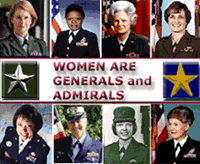
![]()
![]()
![]()

![]()
![]()
![]()




![]()


